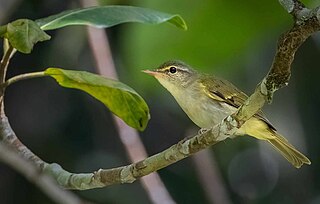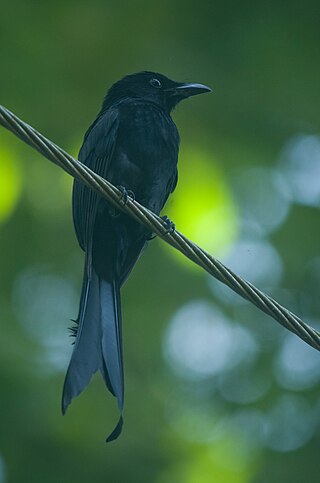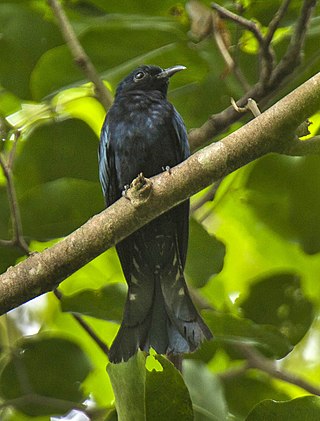
The Philippine leaf warbler is a species of Old World warbler in the family Phylloscopidae. It is endemic to the Philippines on the islands Bohol, Samar, Leyte, Negros, Mindanao, Basilan and the Sulu Archipelago.

The Samar hornbill is a species of hornbill in the family Bucerotidae. It is found in forests on the islands of Samar, Calicoan, Leyte and Bohol in the east-central Philippines. As is the case with all Philippine tarictic hornbills, it has been considered a subspecies of Visayan hornbill Alternatively, it is considered a subspecies of Mindanao hornbill.

The black-faced coucal is a species of cuckoo in the family Cuculidae. It is endemic to the Philippines found in the islands of Mindanao, Basilan Dinagat Islands Bohol, Leyte, Biliran and Samar. It is a striking coucal with its cream head contrasted with a black mask and tail and chestnut wings. Its natural habitat is tropical moist lowland forest.

The Philippine falconet is a species of bird of prey in the family Falconidae, genus Microhierax. It is endemic to the lowland forests of Philippines, and can often be seen near open forest edges hunting flying insects. Philippine falconets nest in woodpecker holes of dead trees, and can be seen fairly commonly within their suitable habitats. Although the Philippine falconet population is declining due to habitat loss, it is still evaluated as "Least Concern" globally.

The Philippine leafbird is a species of bird in the family Chloropseidae. It is endemic to the Philippines. It is found in the islands of Mindanao, Leyte, Samar and Cebu. Its natural habitat is tropical moist lowland forest. It is threatened by habitat loss.

The black-bibbed cicadabird or black-bibbed cuckooshrike is a species of bird in the family Campephagidae. It is endemic to the Philippines. The species is elusive and poorly known. This species has five subspecies that differ considerably in plummage, it is possible that this may actually be a species complex and consists of multiple species.

The Andaman Drongo is a species of bird in the family Dicruridae. The species is endemic to the Andaman Islands of the Indian Ocean. There are two subspecies, the nominate race being found across the main islands of the archipelago, and the race dicruriformis occurring on Great Coco Island and Table Island in the north of the chain

The Philippine fairy-bluebird is a species of bird in the family Irenidae. It is endemic to the Philippines being found in the islands of Luzon, Mindanao, Samar and Bohol.

The black-and-white triller is a species of bird in the family Campephagidae. It is endemic to the Philippines. Its natural habitat is tropical moist lowland forests.

The Philippine oriole or grey-throated oriole is a species of bird in the family Oriolidae. It is endemic to the Philippine found on Mindanao and most of the Visayan Islands.

The azure-breasted pitta is a species of bird in the family Pittidae. It is a striking and colorful bird having colors of red, azure, green, black and white, It is endemic to the islands of Mindanao, Bohol, Leyte and Samar in the Philippines. Along with the Whiskered pitta, it is one of two endemic pittas in the country. Its natural habitat is tropical moist lowland forest. It is threatened by habitat loss.

The stripe-headed rhabdornis or stripe-headed creeper, also known as the stripe-sided rhabdornis, is a species of bird currently placed in the starling family, Sturnidae. It is endemic to the Philippines.

The Philippine jungle flycatcher is a species of passerine bird in the Old World flycatcher family Muscicapidae. It is endemic to the Philippines. Its natural habitat is tropical moist lowland forests up to 1,000 meters above sea level.

The Visayan babbler also known as the Visayan Black-crowned Babbler. is a species of bird in the family Zosteropidae. It is endemic to the Philippines. It is found on Samar, Leyte and Bohol. Its natural habitat is tropical moist lowland forest. It was formerly conspecific to the northern population of the Calabarzon black-crowned babbler but has since been split as a species due to differences in its yellowish throat and whiter belly.

The Philippine drongo-cuckoo is a bird of the cuckoo family found only in the Philippines. It was formerly a subspecies of the Square-tailed drongo-cuckoo. It is found tropical moist lowland forest up to 1,000 meters above sea level. It is declining due to habitat loss.

The Tablas drongo is an Asian bird of the family Dicruridae. It was formerly considered conspecific with the hair-crested drongo.

The orange-tufted spiderhunter is a species of bird in the family Nectariniidae. It is endemic to the Philippines found only on Mindanao and Eastern Visayas. It was originally considered a subspecies of the little spiderhunter.

The Visayan blue fantail is a species of bird in the family Rhipiduridae. It is endemic to the Philippines on the islands of Bohol, Leyte and Samar. Its natural habitat is tropical moist lowland forests. It was previously conspecific with the Mindanao blue fantail.

The northern silvery kingfisher is a species of bird in the family Alcedinidae that is endemic to the Philippines being found in the Visayas on the islands of Bohol, Leyte and Samar. This species and the southern silvery kingfisher, which is found on Mindanao, were formerly considered conspecific and called the silvery kingfisher. Its natural habitats are tropical moist lowland forests, streams and rivers. It is threatened by habitat loss.

The Palawan drongo is an Asian bird of the family Dicruridae. It was formerly considered conspecific with the hair-crested drongo. It is endemic to Palawan.





















